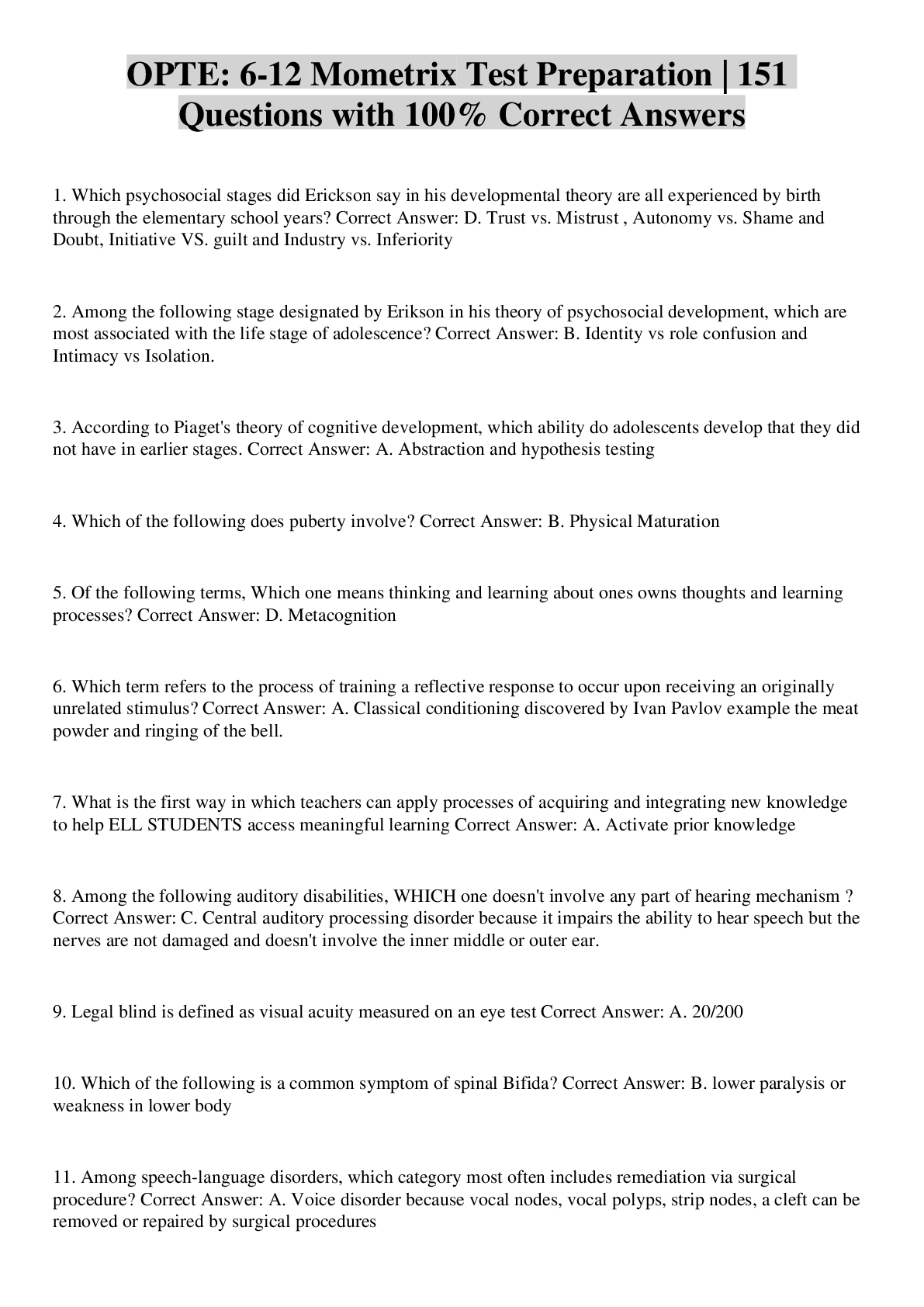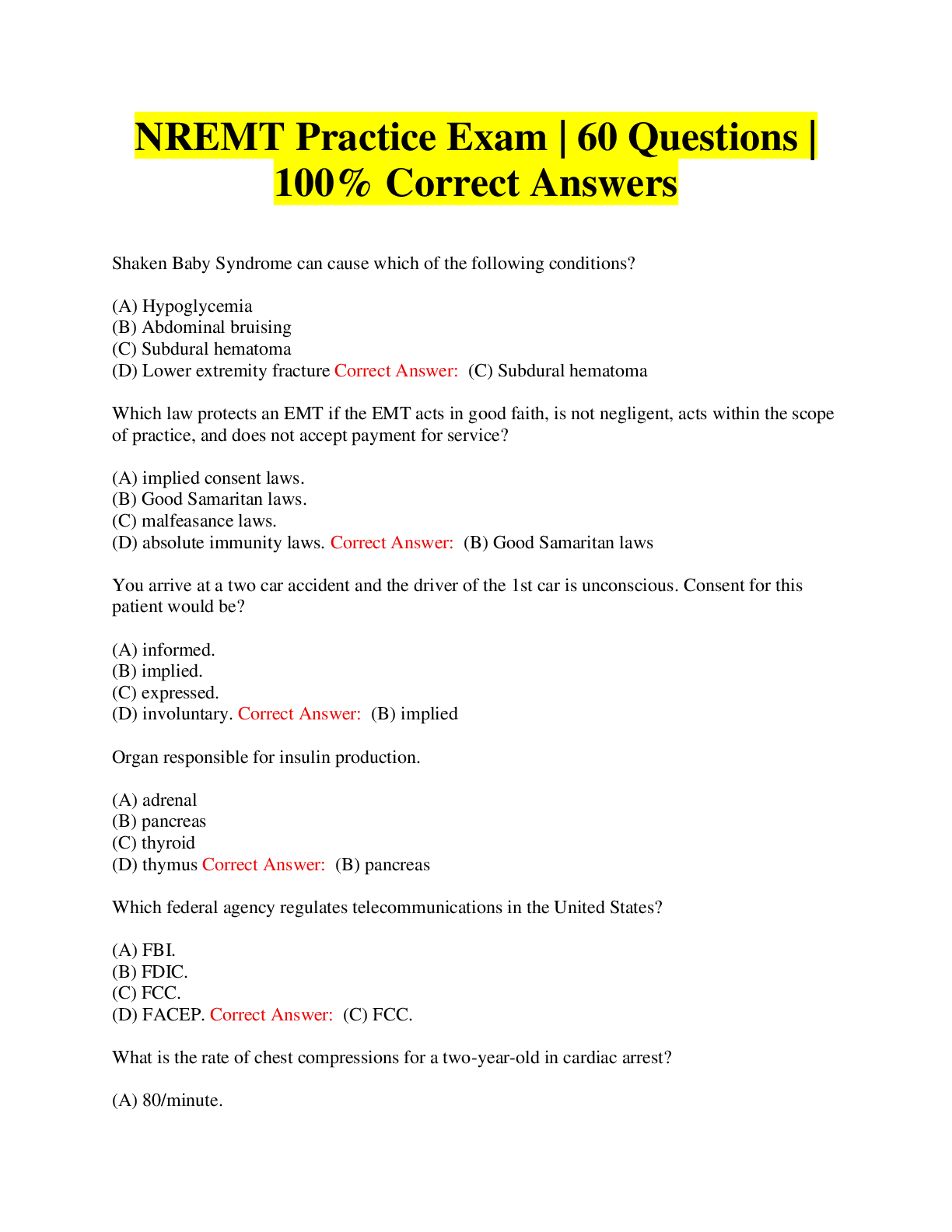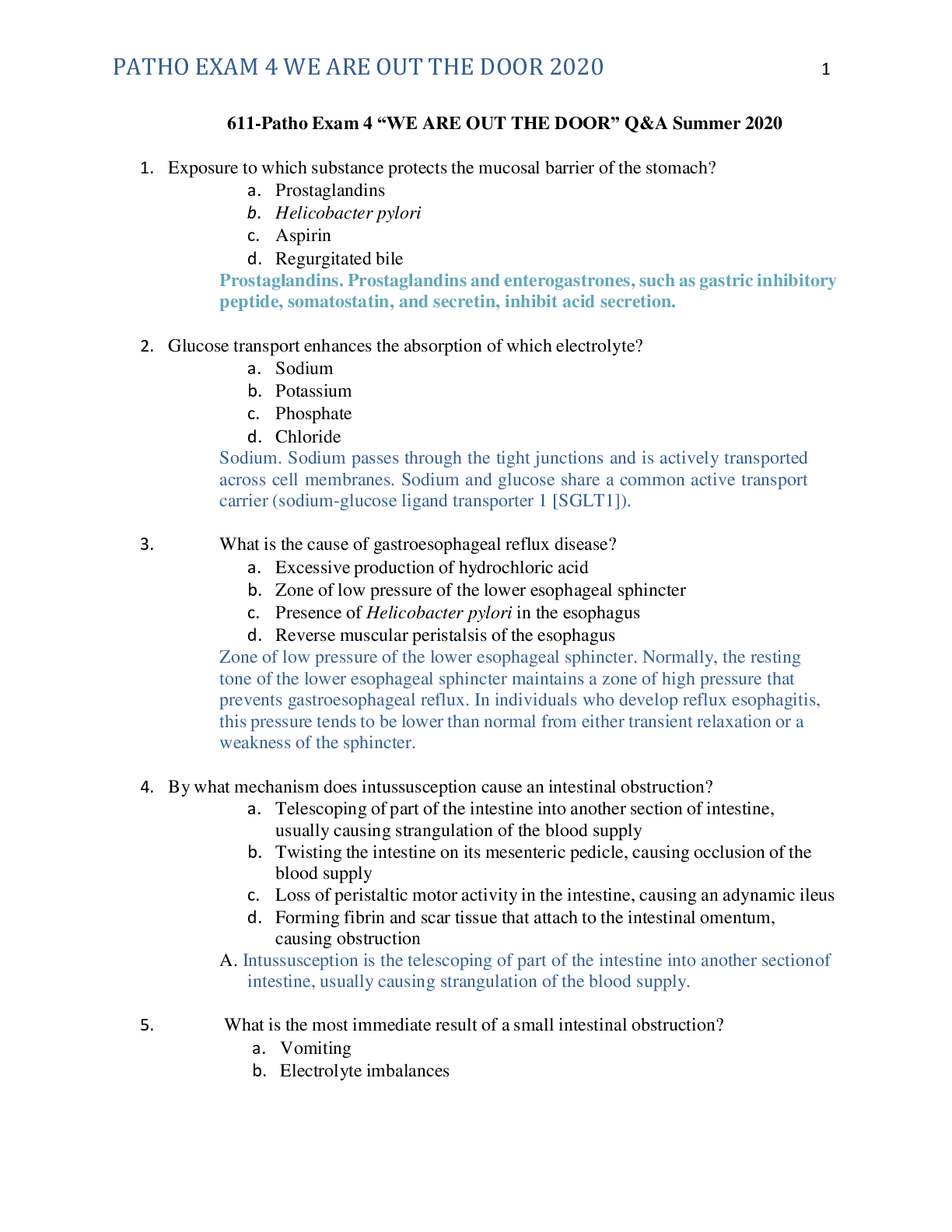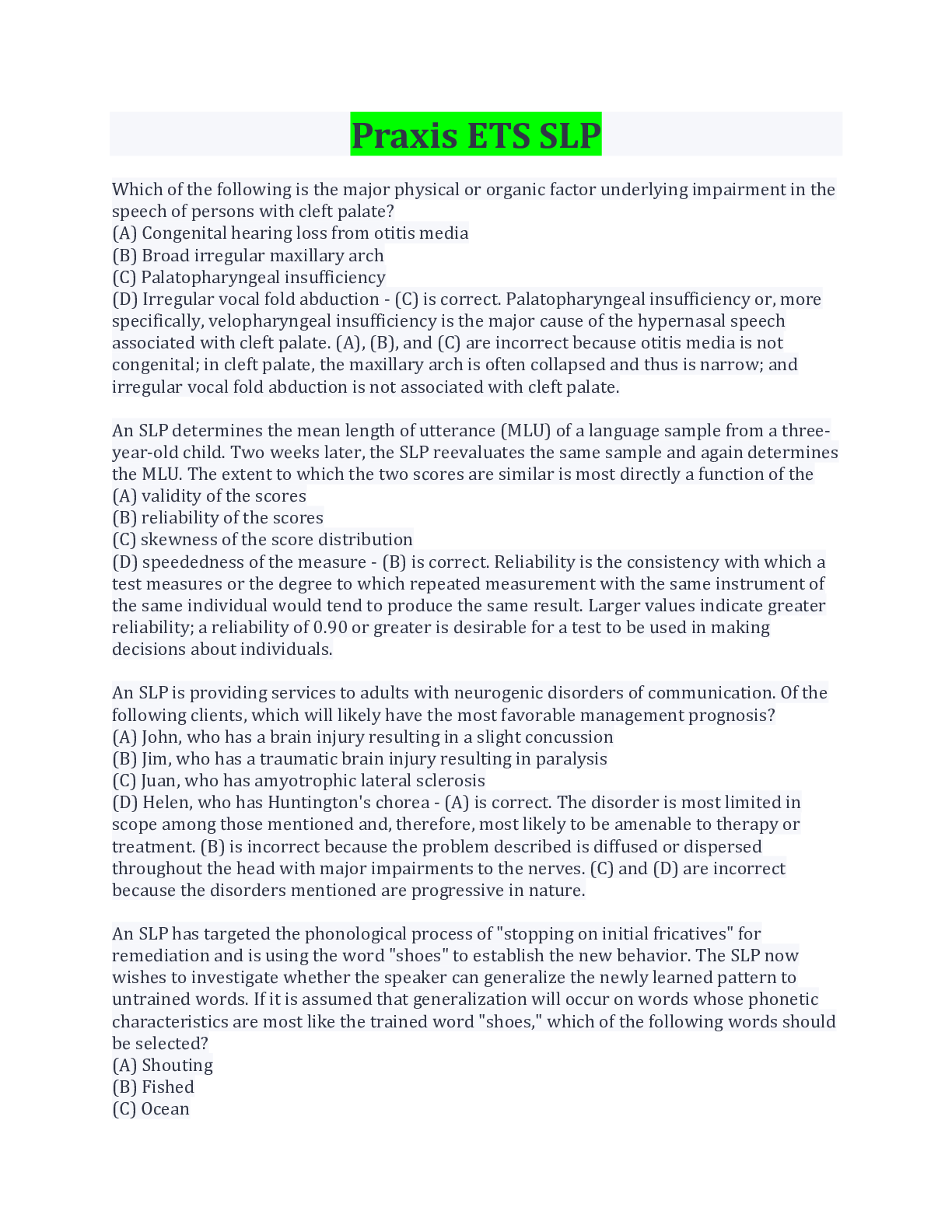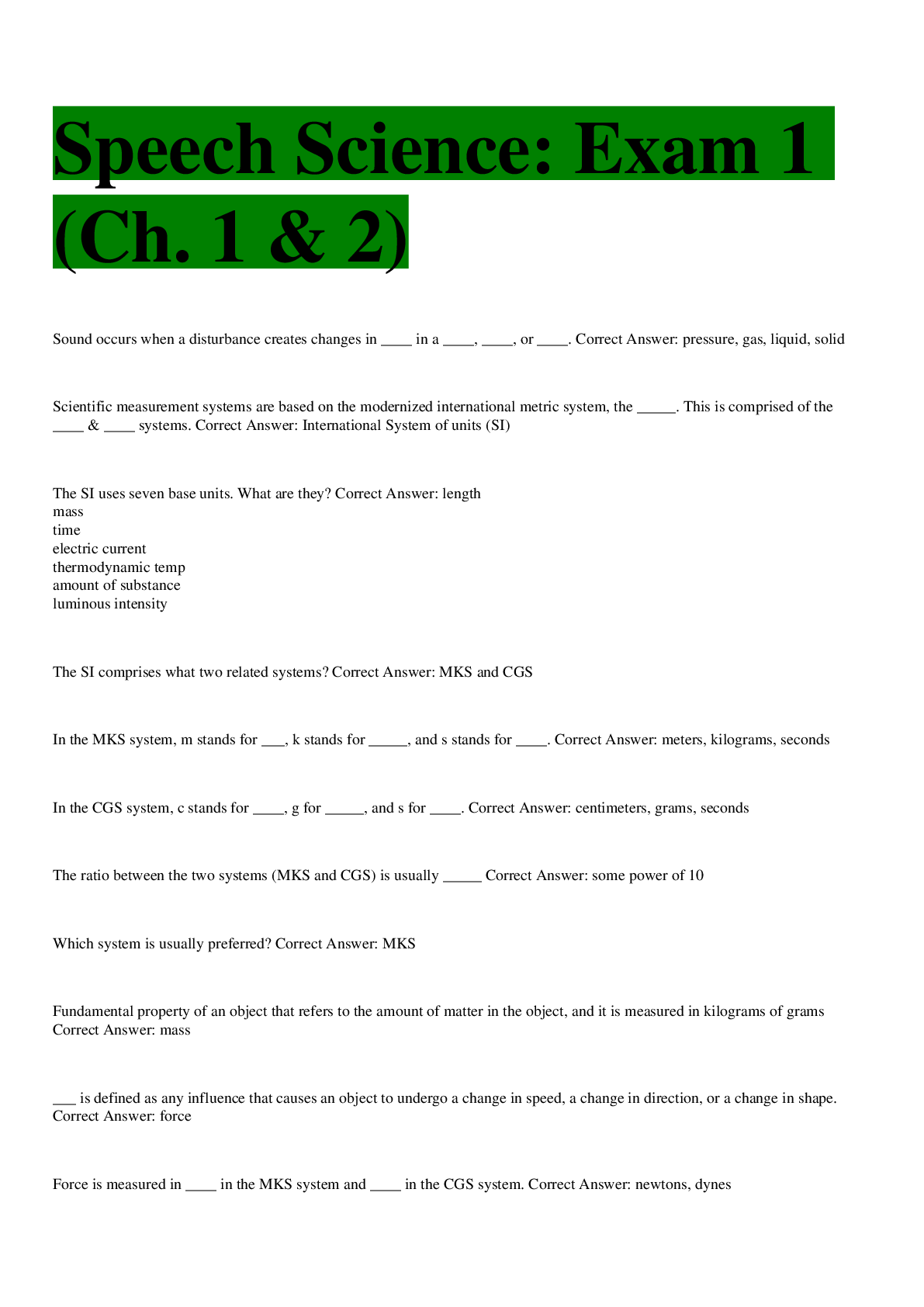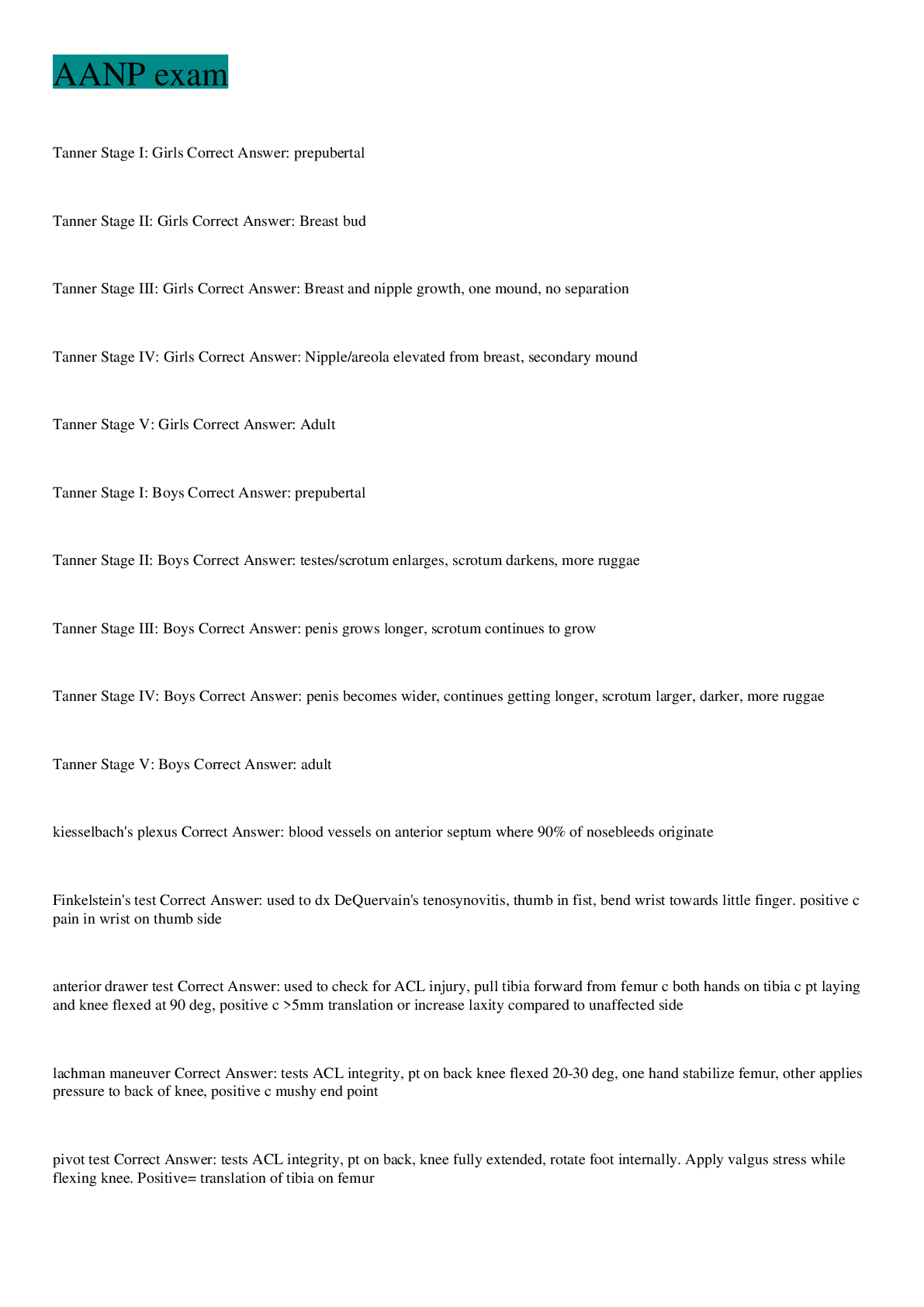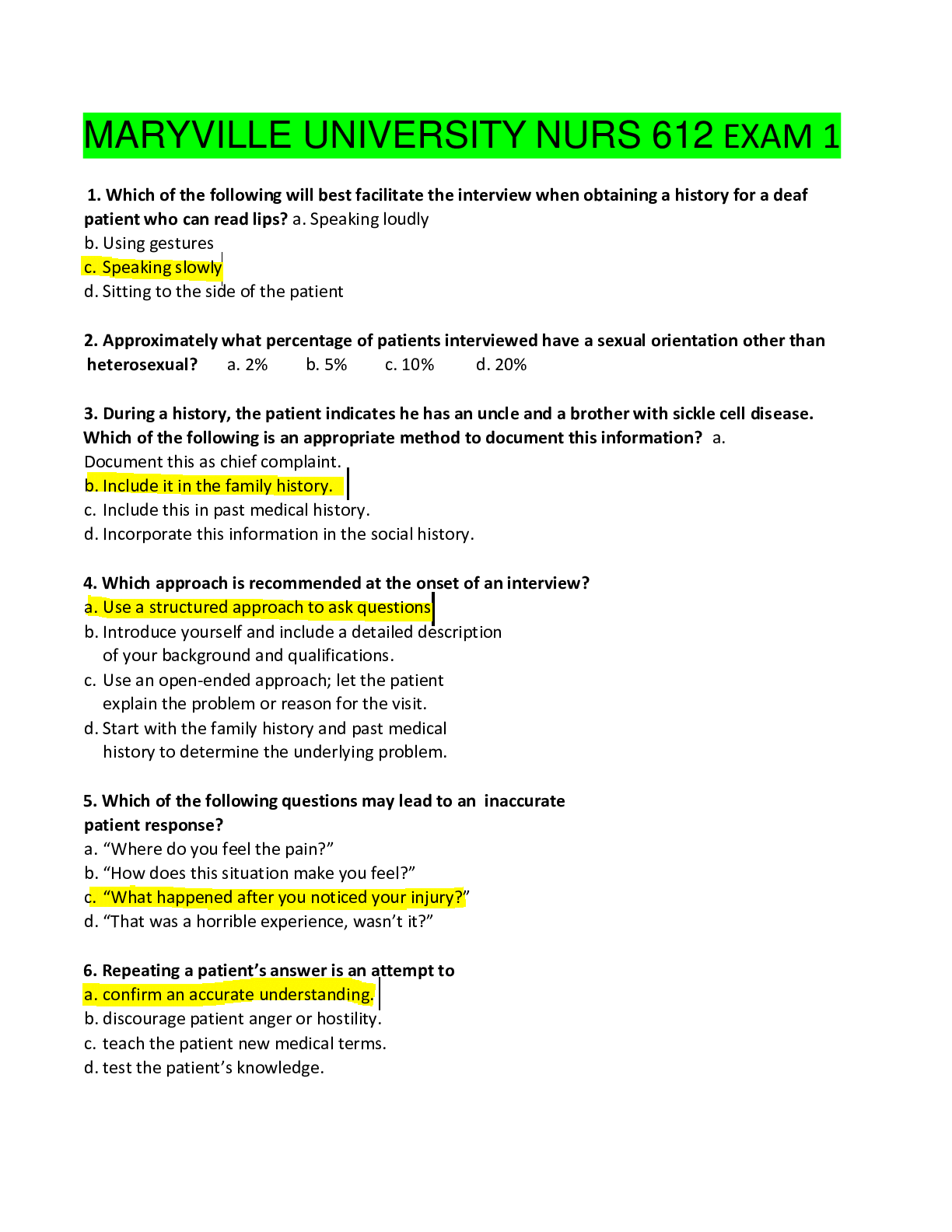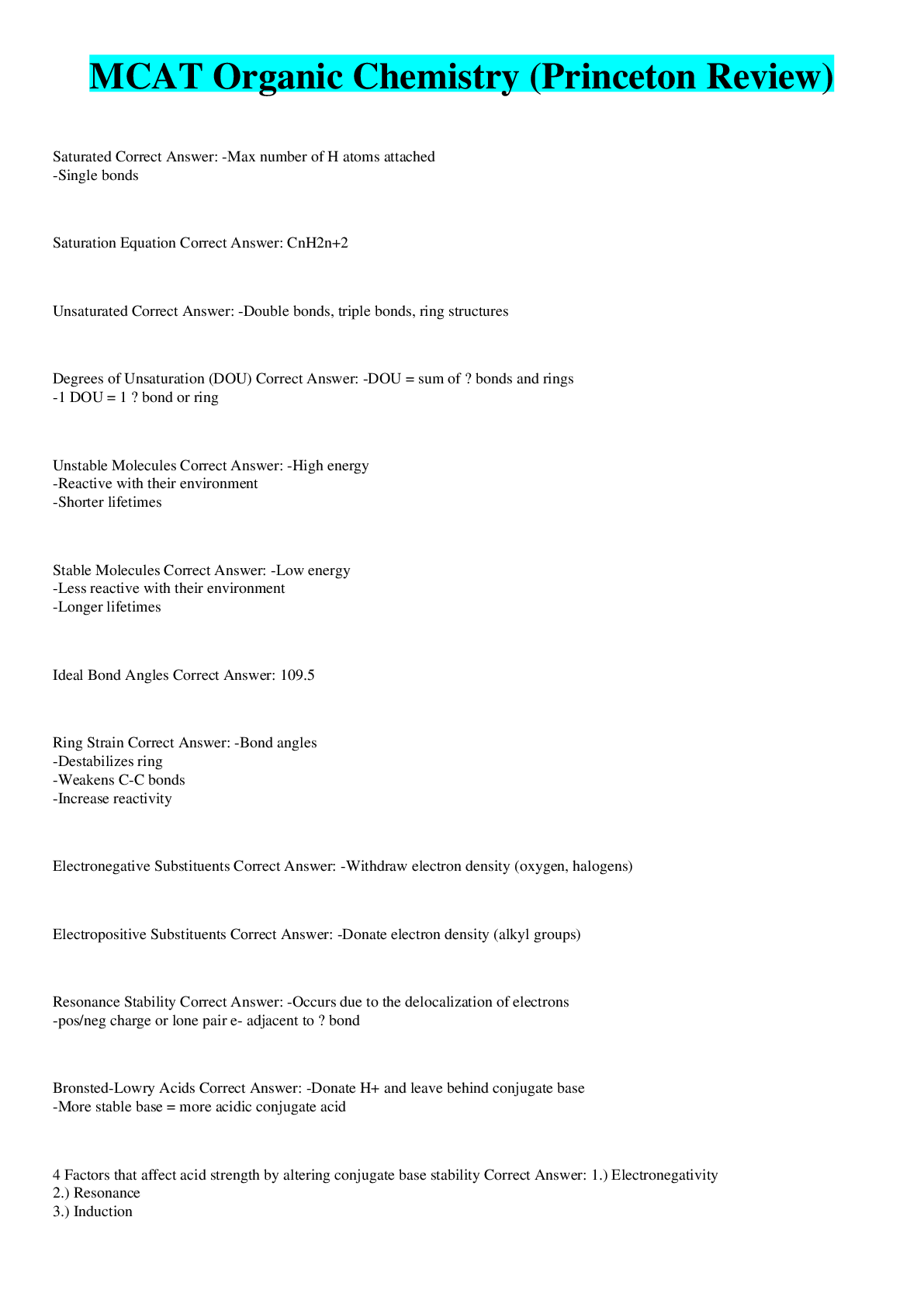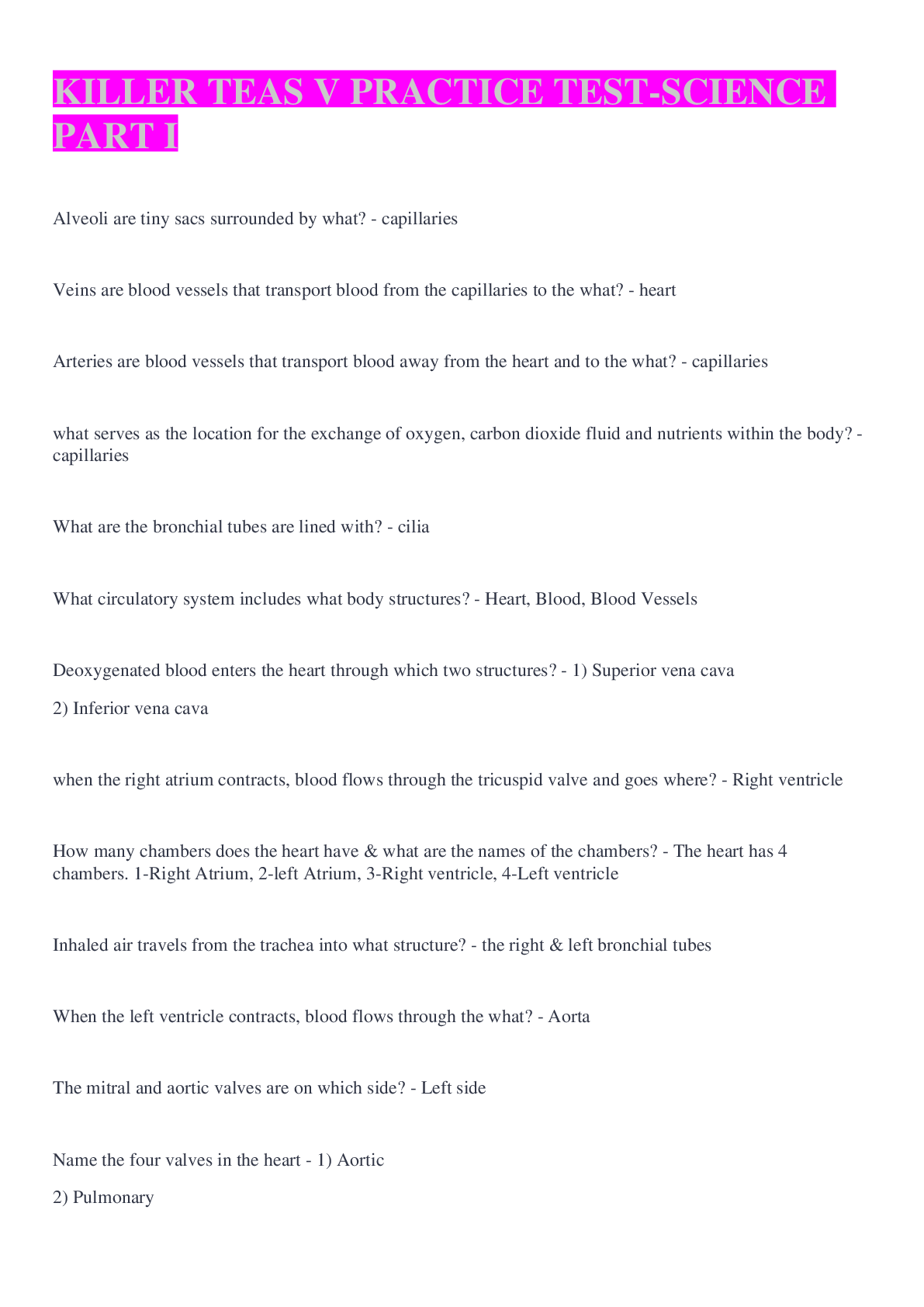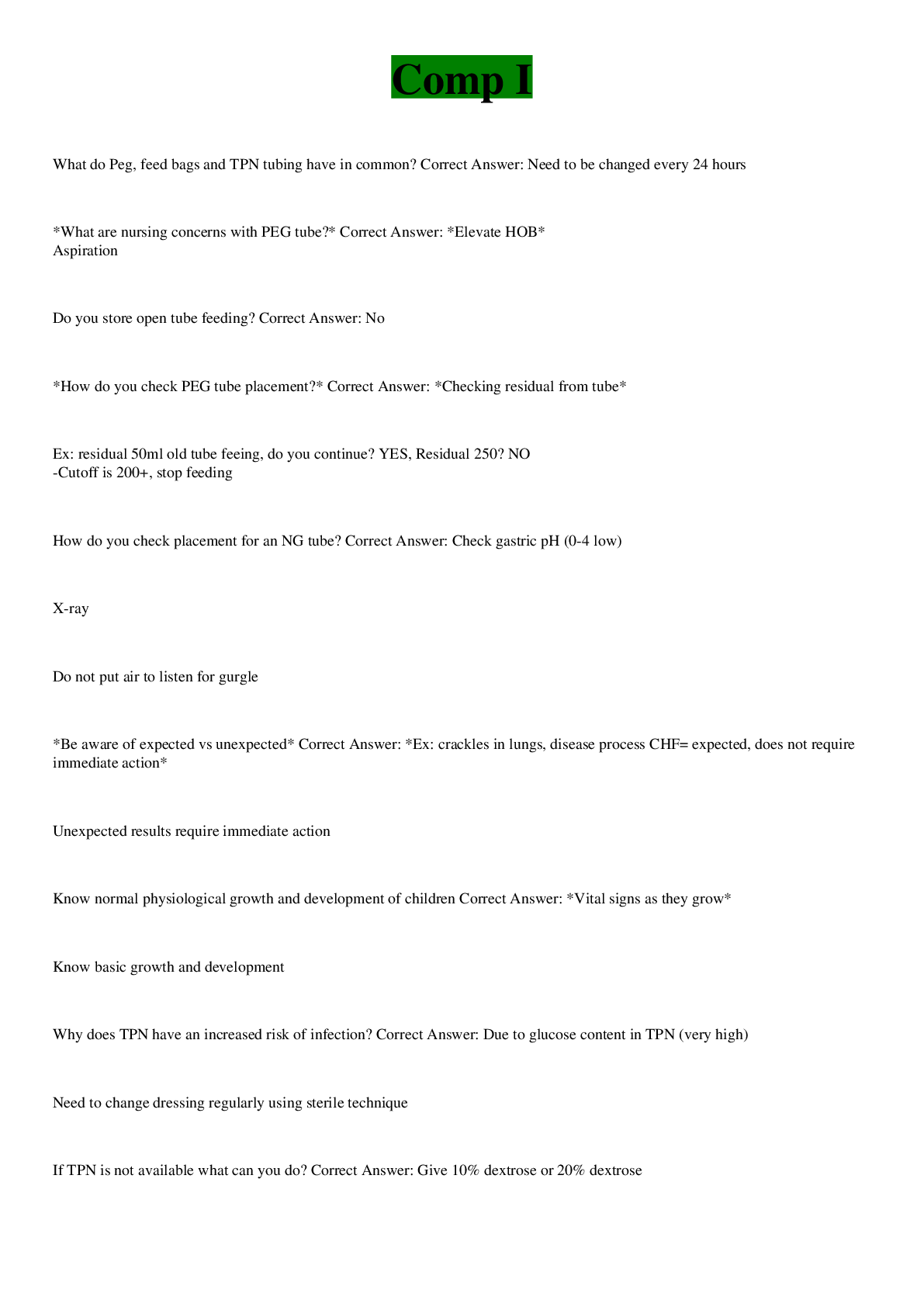Health Care > EXAM > AANP Exam Pearls University of South Alabama QUESTIONS AND ANSWERS| GRADED A (All)
AANP Exam Pearls University of South Alabama QUESTIONS AND ANSWERS| GRADED A
Document Content and Description Below
AANP: Exam Pearls Exam Format • AANP FNP exam contains very few nonclinical questions • Certification tests are designed for entry-level practice • AANP has 15 pilot questions which are not g... raded [there is NO WAY to identify the pilot test questions from the graded questions] • New clinical info [treatment and/or guidelines] released in the last 10 months won’t be on the exam • Questions will be on primary care disorders – if you are guessing, AVOID PICKING EXOTIC DIAGNOSIS AS AN ANSWER Labs• Normal lab results pertinent to a question WILL ONLY BE LISTED ONCE. Use your scratch sheet of paper to jot down these values if given. • Follow the LAB NORMS GIVEN BY AANP not what you learned in NP school • Learn the significance of abnormal lab values AND type of follow-up needed [i.e. elderly gentleman with c/o scalp tenderness + indurated temporal artery, NP suspects temporal arteritis. Screening test is sed rate – which is expected to be MUCH HIGHER than normal value] Good to Know • Expect one question related to dental injury [i.e. completely avulsed permanent tooth should be reimplanted ASAP! It can be transported to dentist in cold milk (not frozen milk) • May be a question on epidemiologic terms (i.e. sensitivity is defined as the ability of a test to detect a person who has the disease. Specificity is defined as the ability of a test to detect a person who is healthy or detect the person without the disease) • Learn definition of some research study designs: cohort follows a group of people who share some common characteristics to observe the development of a disease over time – Framingham nurses health study • Emergent conditions that will present in primary care clinics will be on the exam: navicular fracture, MI, cauda equina syndrome, anaphylaxis, angioedema, meningococcal meningitis • Know some anatomic areas: trauma to Kiesselbach’s plexus = anterior nosebleed • Some questions ask about “gold-standard test” or the “diagnostic test for the condition”: sickle cell anemia, G6PD anemia, and alpha/beta thalassemia = hgb electrophoresis • Disease states are usually presented in their “full-blown classic” textbook presentation: acute mononucleosis, teen will have classic triad of sore throat, prolonged fatigue, and enlarged cervical nodes. If patient is older with same signs/symptoms, it is still mononucleosis reactivated type • Ethic background may provide clues to disease: alpha thal = southeast Asia / Filipinos; beta thal = Mediterranean • NO ASYMPTOMATIC or BORDERLINE CASES OF DISEASE STATES WILL BE ON THE EXAM: IDA in “real life” don’t present often with pica or spoon-shaped nails, on the exam they will have these clinical findings • Be familiar with lupus and SLE: malar rash (butterfly) = lupus. Instruct patient to avoid / minimize sun exposure r/t photosensitivity. • Be familiar with polymyalgia rheumatica (PRM): 1st line tx is long-term steroids. Long-term, low-dose steroids are commonly used to control symptoms (pain, severe stiffness in shoulders / hip girdle). PMR patients are at HIGH RISK FOR TEMPORAL ARTERITIS. • Gold standard exam for temporal arteritis: biopsy + refer patient to optho for management. • Learn the disorders for which maneuvers are used and what a positive report means: o Finkelstein’s test—positive in De Quervain’s tenosynovitis o Anterior drawer maneuver and Lachman maneuver—positive if anterior cruciate ligament (ACL) of the knee is damaged. The knee may also be unstable. o McMurray’s sign—positive in meniscus injuries of the knee • Conditions that NEED a radiologic test: damaged joints – order Xray 1st (but MRI is the gold standard) • Abnormal eye findings in DM (diabetic retinopathy) and HTN (hypertensive retinopathy) should be MEMORIZED and learn to distinguish each one: o Diabetic retinopathy = neovascularization, cotton wool spots, microaneurysms o Hypertensive retinopathy = AV nicking, silver and/or copper wire arterioles • Become knowledgeable about physical exam “normal” and “abnormal” findings: o Checking DTRs in patient w/severe sciatica or diabetic peripheral neuropathy: ankle jerk reflex (Achilles reflex) may be absent or hypoactive. Scoring absent (0), hypoactive (1), normal (2), hyperactive (3), and clonus (4). • ONLY A FEW QUESTIONS WILL BE ON BENIGN or PHYSIOLOGIC VARIANTS: benign S4 heart sounds may be auscultated in some elderly pt. Torus palantinus and fishtail uvula may be seen during the oral exam in a few patients. • If the question is asking for the initial or screening lab test, it will probably be a “cheap” and readily available test: CBC (complete blood count (CBC) to screen for anemia • There are some questions on theories and conceptual models: Stages of change or “decision” theory (Prochaska) includes concepts such as precontemplation, contemplation, preparation, action, and maintenance. • Other health theorists who have been included on the exams in the past are (not inclusive): o Alfred Bandura (self-efficacy), Erik Erikson, Sigmund Freud, Elisabeth Kübler-Ross (grieving), and others o If a small child expresses a desire to marry a parent of the opposite sex: the child is in the oedipal stage (Freud). Child’s age is about 5 to 6 years (preschool to kindergarten). o Starting at the age of about 11 years, most children can understand abstract concepts (early abstract thinking) and are better at logical thinking. o When performing the Mini-Mental State Exam, when the NP is asking about “proverbs,” the nurse is assessing the patient’s ability to understand abstract concepts. • Keep these good communication rules in mind: Ask open-ended questions, do not reassure patients, avoid angering the patient, and respect the patient’s culture. • There may be two to three questions relating to abuse: child abuse, domestic abuse, elderly abuse Antibiotics & Medications • Know the difference between 1st and 2nd line abx: AOM in 7 yr old treated with amoxicillin returns in 48hr without improvement (continued ear pain, bulging TM). Next step is to d/c amox and start child on 2nd line abx Augmentin BID x10 days • Be familiar with alternative abx for PCN-allergic patients: If patient has gram+ infection, prescribe macrolides, clinda, quinolones = levo or moxi • Patient responds well to macrolides but thinks they’re allergic to erythromycin (nausea, GI upset): inform patient she had an adverse rx, not a true allergic (hives/angioedema): switch pt from erythromycin to azithromycin (z-pack) • Fails to respond to initial medication: add another medication per treatment guidelines (i.e. COPD pt prescribed Atrovent for dyspnea. On follow-up, patient complains symptoms are not relieved. Next step is to prescribe albuterol (Ventolin) or combo inhaler) • Commonly used drugs with rare (potentially fatal) adverse effects: ACE-I = angioedema. Common side effect of ACEIs = dry cough (up to 10%) • Learn the preferred and/or 1st line drug to tx some diseases: ACEI/ARB is preferred for HTN in DM and patients with mild-mod renal disease = renal protective properties • When meds are used in answer options, they will be listed either by name (generic and brand name) or by drug class alone: ipratropium (Atrovent) or an anticholinergic • Most of the drugs mentioned in the exam are the well-recognized drugs: o Penicillin: Amoxicillin (broad-spectrum penicillin), penicillin VK o Macrolide: Erythromycin, azithromycin (Z-Pack), or clarithromycin (Biaxin) o Cephalosporins: First-generation (Keflex), second-generation (Cefaclor, Ceftin, Cefzil), third generation (Rocephin, Suprax, Omnicef) o Quinolones: Ciprofloxacin (Cipro), ofloxacin (Floxin) o Quinolones with gram-positive coverage: Levofloxacin (Levaquin), moxifloxacin (Avelox), gatifloxacin (Tequin) o Sulfa: Trimethoprim-sulfamethoxazole (Bactrim, Septra), nitrofurantoin (Macrobid) o Tetracyclines: Tetracycline, doxycycline, minocycline (Minocin) o Nonsteroidal anti-inflammatory drug (NSAID): Ibuprofen, naproxen (Aleve, Anaprox) o COX-2 inhibitor: Celecoxib (Celebrex) • Category B drugs are ALLOWED for pregnant or lactating women: Pain relief, pick acetaminophen (Tylenol) instead of NSAIDs such as ibuprofen (Advil) or naproxen (Aleve, Anaprox). Avoid nitrofurantoin and sulfa drugs du [Show More]
Last updated: 2 years ago
Preview 1 out of 55 pages
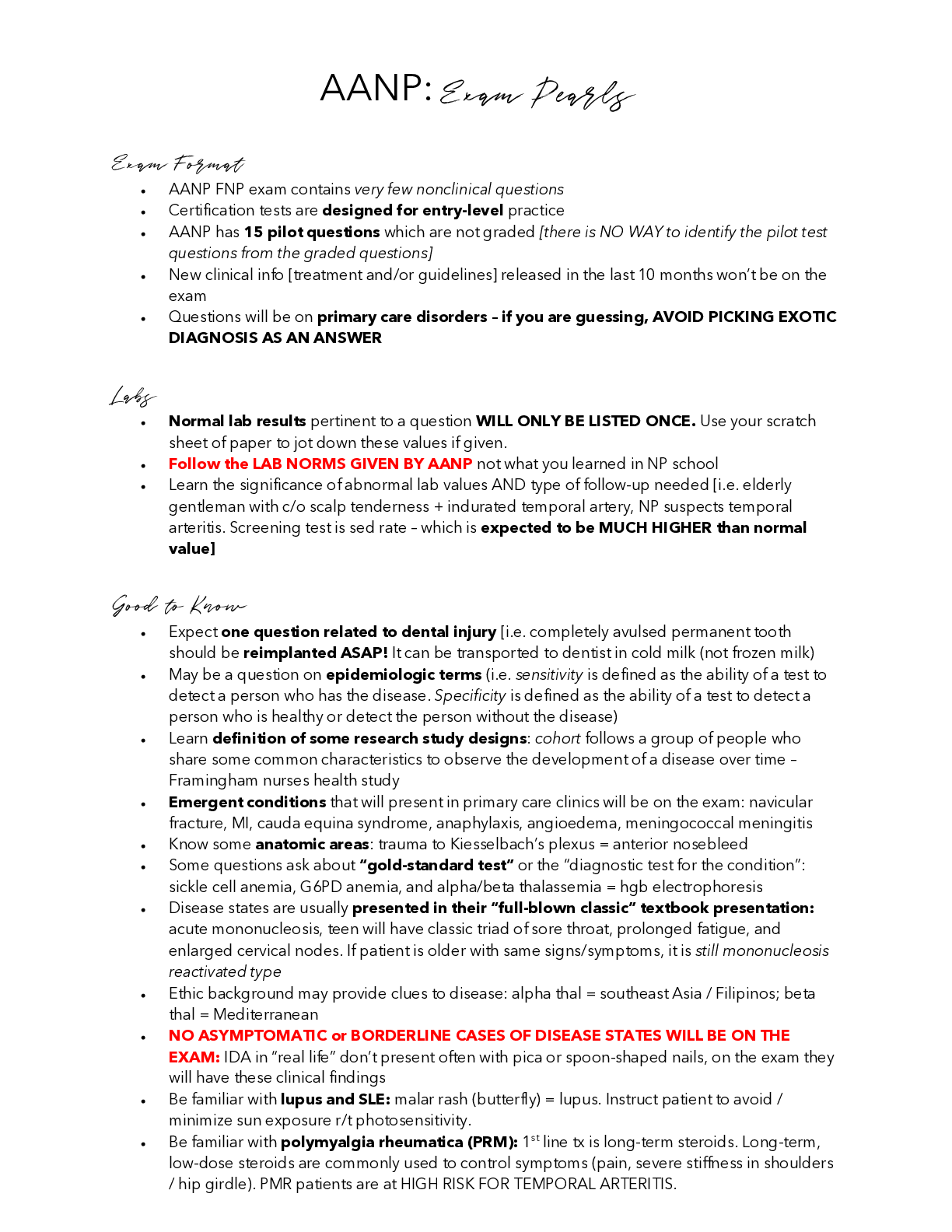
Buy this document to get the full access instantly
Instant Download Access after purchase
Buy NowInstant download
We Accept:

Reviews( 0 )
$17.50
Can't find what you want? Try our AI powered Search
Document information
Connected school, study & course
About the document
Uploaded On
Sep 13, 2022
Number of pages
55
Written in
Additional information
This document has been written for:
Uploaded
Sep 13, 2022
Downloads
0
Views
44

